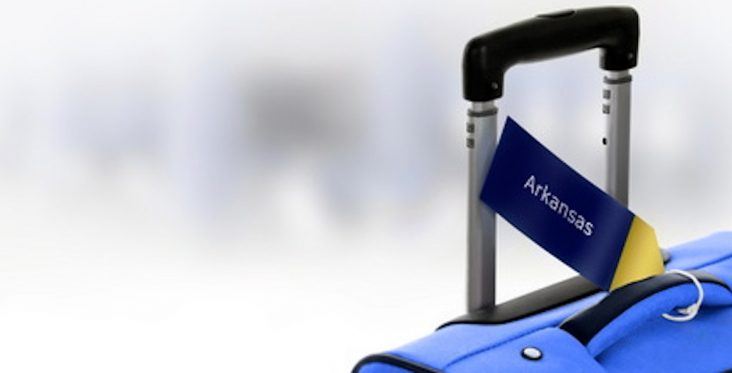Tradeoff to flying cheap might be delay of days, not hours
by August 15, 2017 6:30 am 398 views

Arkansas. Blue suitcase with label at airport.
Passengers might love the low cost of flights for carriers, such as Allegiant, but the tradeoff might be they don’t reach their destination on the day they planned to arrive.
A challenge with low-cost carriers has been the frequency of flights when it comes to delays caused by weather problems or mechanical issues, said Scott Van Laningham, CEO of the Northwest Arkansas Regional Airport.
“Allegiant is one of the classic examples of if they have a mechanical [issue] or there’s a weather problem, it’s not necessarily a few hours, it can be a substantial delay,” Van Laningham said. “We know those things happen on a semi-regular basis, and frankly it’s a challenge. Particularly for the folks that if you’re going to Vegas for a weekend and you’re scheduled to fly out on Thursday, but you can’t get out until Friday because of a problem — that is a serious impact on your weekend.”
Low-cost carriers such as Allegiant Travel and Spirit Airlines have struggled to make their flights on time because of issues ranging from pilots not taking flights to aircraft maintenance procedures, according to a July 31 article in Bloomberg. Allegiant, which accounts for about 7% of XNA’s enplanements, has had issues with the latter. Other carriers that operate at the airport include American Airlines, Delta and United.
In July, Las Vegas-based Allegiant reported its total passengers rose 7.1% to 1.34 million, from 1.25 million in the same month in 2016. For the first six months of the year, the carrier’s earnings have fallen 32.2% to $90.1 million, from $132.8 million in the same period in 2016. Revenue has risen 12% to $776.5 million, from $693.5 million.
For XNA, the number of enplanements, or outbound passengers, hit a record-high in June of 68,274, rising 4% from the same month in 2016. Enplanements at the Bill and Hillary Clinton National Airport in Little Rock rose 2% to 98,564, while the Fort Smith Regional Airport saw enplanements rise 5% to 8,304.
Allegiant tends to add more flights in the summer for travelers at XNA, airport director Kelly Johnson said. The carrier operates from the B gate at the airport, and is charged a per-turn rate, or a landing fee, to operate there. United also operates from the gate and is charged the same amount. Other carriers, which operate at a higher frequency, use the A gate and are not charged a per-turn rate but a gate rental fee, Johnson said. The airport’s total costs are about in the middle for the size of the airport at $7 per enplaned passenger.
“And it is still $7 if the airline ticket is $700,” Van Laningham said. “We’re still just getting the seven.”
Johnson said she attended the Allegiant meeting in April, and XNA’s costs for the carrier were right in the middle.
BIGGER PLANES
Maurice Gallagher Jr., chairman and CEO for Allegiant Travel Co., said the company was “well into the wind down of our MD-80 fleet. We have taken delivery of our first four new 186-seat A320 aircraft from Airbus as of July 26.” The company expects to place into service another 10 Airbus aircraft, including six more new A320s this year. In June, the company purchased 13 used A320s and plans to retire all the MD-80s by the end of 2019.
As of June 30, the company was operating 88 aircraft, and 45 were the 166-seat MD-80 aircraft.
When asked whether the carrier was changing out its fleet at XNA, Van Laningham said several carriers have been bringing in larger aircraft.
“Oftentimes, those tend to be planes that also have a first class cabin section in part because of the high business travel, but we are starting to see larger planes. The nice thing about that even if you’re not traveling business class is that just means more capacity, more opportunities to get where you need to go,” he said.
And passengers are taking advantage of the opportunity to fly at a low cost on Allegiant.
“They are folks that but for that low-cost Allegiant option might not have been able to go on that trip,” Van Laningham said.
But whether XNA will attract another low-cost carrier is uncertain.
“That’s been one of our highest priorities for the last four or five years,” he said. “We are working with the Northwest Arkansas Council in identifying potential new entrants, obviously low-cost carriers at the top of our list. … It takes a while. They’ve got to get comfortable with the market. They’ve got to understand we’re a high business travel market, so business travelers often have status on the existing carriers. So it’s not just a question of somebody coming in. They’ve got to talk folks into going to a new carrier, and that’s a bit of a challenge.”
INDUSTRY TRENDS
In May, passenger enplanements on all U.S. scheduled airlines reached an all-time high of 70.9 million, rising 3.1% from the same month in 2016, according to the U.S. Department of Transportation’s Bureau of Transportation Statistics. May marked the third consecutive month enplanements have risen and were up 0.7% from April.
Enplanements for domestic flights rose 2.6% in May from the same month in 2016, while international flights rose 6.1%.
In June, total employment in the U.S. airline industry, which includes passenger, charter and cargo segments, rose 2.7% to 698,901, from 679,996 in the same month in 2016. Between May and June, the industry added 2,887 jobs.
